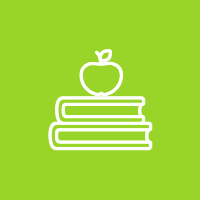A plant is a biological system. Its systems, processes, and components enable it to grow and reproduce. By observing, collecting, and classifying seeds, students are introduced to one aspect of a plant’s reproductive system.
This is one of 96 activities that can be found in PLT’s PreK-8 Environmental Education Activity Guide. To get the activity, attend a training either in person or online and receive PLT’s PreK-8 Guide. Below are some supporting resources for this activity.
STEM STRATEGIES 
Engage students in real-world applications of STEM (science, technology, engineering, math) education.
Try these STEM Connections for this PLT activity:
RECOMMENDED READING 
Expand your students’ learning and imaginations. Help students meet their reading goals, while building upon concepts learned in this activity, with the following children’s book recommendations:
FAMILY ACTIVITY 
Try a simple variation of this activity to engage children in the outdoors at home. Download this fun and easy-to-do family activity.
ADDITIONAL RESOURCES 
The following tools and resources may be used to enhance the activity.
-
Seeds Are Smart
The Jeffers Foundation, whose mission is to foster environmental stewardship through education, has created several instructional videos for children-at-home on various environmental topics. For example, in Seeds are Smart, children look at different types and shapes of seeds, learn where seeds come from and how to identify them, how seeds are an important part of a squirrel’s diet, and ways seeds get carried, for example, by a bird or with the wind. This video pairs well with PLT’s activity called Have Seeds, Will Travel that teaches children about plant reproduction and seed dispersal. Whether floating on the air, getting carried by animals, or catching waves, plants use many techniques to send their seeds far and wide. Also check out our suggestions to enrich the activity with a focus on STEM, and our Family Activity adaptation.
-
Discover Inspiring Women in Science: Barbara McClintock
We all know Marie Curie, the first woman to win a Nobel Prize for pioneering research on radioactivity. But there are many more women scientists, mathematicians, and engineers who have made incredible advances in their fields. Beyond Curie is a celebration of 40 of these amazing women in STEM fields, including 16 Nobel Peace Prize winners. Each one has overcome countless challenges in the pursuit of knowledge, understanding, and impact. Use these posters to share their stories and inspire your students to consider a field in STEM. Pair this activity with a poster of Barbara McClintock.
-
Ag Across America
Ag Across America is an online geography game for grades 3-5. With this game, students will learn more about how farms provide our food, fiber, and energy. The game guides students through a series of video and trivia questions about farms across the U.S. When you answer correctly, players collect items to have on their own virtual farm. Find more games and resources for young learners at My American Farm, and professional development opportunities for educators through On the Farm STEM.
-
Into the Outdoors: The Importance of Plants and Pollinators
Did you know that 1/3 of the food you eat from the United States depends on pollinators? Pollinators, such as bees, play a vital role in how plants develop fruit and spread their seeds. Into the Outdoors explains this role in a 5-minute video called Plants and Pollinators. The video also explains how other organisms, such as bacteria, help plants grow and reproduce using nitrogen fixation. This video is suitable for elementary and middle school students.
-
Seed Racers
Are you looking for a fun and interactive way to teach your students about seeds? Why not have your students play the Seed Racers game? In this simple point and click style game, students learn about the types, features, and dispersal methods of many different kinds of seeds. Students work through multiple missions to collect seeds, all while learning about how seeds move from trees and other plants to new sites for germination and growth.
-
STEM Teaching Tools
The University of Washington’s Institute of Science and Math created Practice Briefs. These free articles highlight ways of working on specific issues that come up during STEM teaching. These briefs helps K-12 educators and administrators stay informed on teaching STEM issues, including STEM issues relating to teaching NGSS and implementing meaningful STEM learning. Each brief is separated into digestible sections and includes recommended actions for educators.
-
Seed Dispersal Methods
This one-page handout offers explanations of the different ways seeds can travel, and examples of seeds for each method.
-
Seed Characteristic Chart
Investigate different types of seeds, and organized and describe them using this helpful chart.


